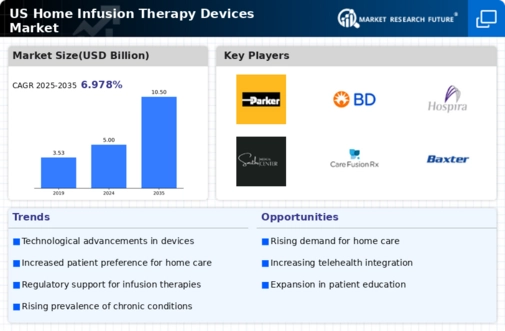Rising Prevalence of Chronic Diseases
The increasing incidence of chronic diseases in the US is a primary driver for the home infusion-therapy-devices market. Conditions such as diabetes, cancer, and heart disease necessitate ongoing treatment, often requiring infusion therapies. According to the Centers for Disease Control and Prevention (CDC), approximately 60% of adults in the US have at least one chronic condition, which underscores the demand for effective home-based treatment options. This trend is likely to propel the market forward as patients seek convenient and effective ways to manage their health at home, reducing the need for frequent hospital visits. The home infusion-therapy-devices market is thus positioned to grow as healthcare systems adapt to meet the needs of this expanding patient population.
Shift Towards Home Healthcare Services
The ongoing shift towards home healthcare services is a significant driver for the home infusion therapy devices market. Patients increasingly prefer receiving care in the comfort of their homes, which is often seen as a more convenient and less stressful option compared to traditional hospital settings. This trend is supported by a growing body of evidence suggesting that home-based care can lead to better patient outcomes and lower healthcare costs. The home infusion-therapy-devices market is likely to benefit from this shift, as healthcare providers expand their services to include home infusion therapies, thereby enhancing patient access to necessary treatments while reducing the burden on healthcare facilities.
Cost-Effectiveness of Home Infusion Therapy
The cost-effectiveness of home infusion therapy is emerging as a significant driver for the home infusion-therapy-devices market. Home-based treatments can often reduce overall healthcare costs by minimizing hospital stays and associated expenses. According to various studies, home infusion therapy can save healthcare systems up to 50% compared to traditional inpatient care. This financial incentive is likely to encourage healthcare providers and insurers to promote home infusion therapies as a viable alternative. As the focus on cost containment in healthcare continues to grow, the home infusion-therapy-devices market is expected to expand, driven by the economic advantages of home-based care.
Technological Innovations in Infusion Devices
Technological advancements in infusion devices are significantly influencing the home infusion-therapy-devices market. Innovations such as smart infusion pumps, which offer enhanced accuracy and safety features, are becoming increasingly prevalent. These devices often include features like dose error reduction systems and wireless connectivity, allowing for better patient monitoring and data collection. The market for infusion pumps alone is projected to reach approximately $5 billion by 2026, indicating a robust growth trajectory. As healthcare providers and patients alike recognize the benefits of these advanced technologies, the demand for home infusion-therapy-devices is expected to rise, facilitating more effective and safer home care solutions.
Aging Population and Increased Demand for Home Care
The aging population in the US is a critical factor driving the home infusion therapy devices market. As the baby boomer generation continues to age, the demand for home healthcare services, including infusion therapies, is expected to rise. The US Census Bureau projects that by 2030, all baby boomers will be over 65 years old, leading to a substantial increase in the number of individuals requiring chronic disease management and long-term care. This demographic shift is likely to create a robust market for home infusion-therapy-devices, as older adults often prefer receiving care at home, where they feel more comfortable and secure.





















Leave a Comment